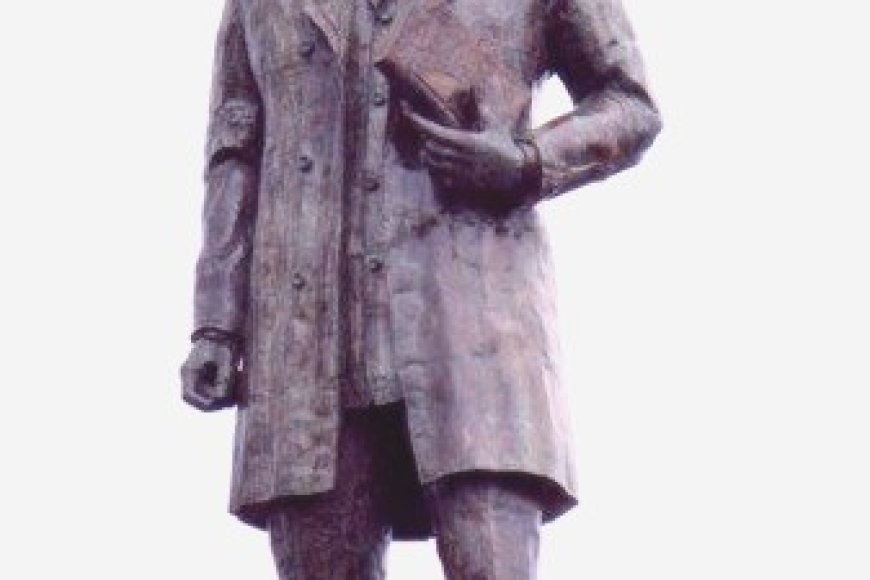Wednesday, April 30, 2025 | 2 a.m.
U.S. philantropist and oil magnate John D. Rockefeller gives a dime to a child. After “robber barons” like Rockefeller amassed a staggering amount of wealth in the late 19th century, the progressive movement pushed to get the income tax passed in the early 1900s for a more equal economy. Photo by: AP
Editor’s note: “Behind the News“ is the product of Sun staff assisted by the Sun’s AI lab, which includes a variety of tools such as Anthropic’s Claude, Perplexity AI, Google Gemini and ChatGPT.
Last week, President Donald Trump used wording to suggest that the federal income tax arrived in 1913 via a suspicious effort to destroy the “beauty” of the prior regime of tariffs.
What the president left out was this: The federal income tax was a full-blown constitutional amendment and was overwhelming supported by the American people specifically because tariffs were consumption and a tool to increase income inequality and to make the rich much richer and keep the poor in poverty.
Trump has frequently discussed how much richer “we were” during the era of tariffs. However, the “we” he’s referring to must mean the wealthy, because the average American was poorer.
With April 15’s tax day still fresh in mind, this Behind the News explores the origin of the federal income tax and finds surprising comparisons between the abuses of the Gilded Age and today.
The ratification of the 16th Amendment in 1913, authorizing a federal income tax, emerged from a confluence of economic inequality, populist discontent and the limitations of relying on tariffs and excise taxes. To understand its origins, we must examine the stark income disparities of the Gilded Age, the regressive nature of pre-20th-century tax policies, and the political movements that reshaped America’s fiscal landscape.
Economic inequality
and the Gilded Age
By the late 19th century, America had become a nation of extremes. Industrialization concentrated wealth in the hands of tycoons like John D. Rockefeller and Andrew Carnegie, while workers and farmers faced stagnant wages and volatile commodity prices. In 1913, the top 1% of earners claimed 18% of national income, with Rockefeller declaring, “When a man has accumulated a sum of money within the law ... the people no longer have any right to share in the earnings”[1][27].
This inequality was staggering:
• By 1897, the richest 4,000 families (less than 1% of the population) held as much wealth as the other 11.6 million families combined[2]
• The wealthiest 2% of households owned more than a third of the nation’s wealth; the top 10% owned about three-quarters[3]
• The richest 1% owned over half of all property, while the bottom 44% owned just over 1%[28]
• In 1890, 11 million of 12 million U.S. families earned less than $1,200 per year (about $37,000 in today’s dollars), with the average wage for this group at $380 (about $12,000 today)[4].
Major abuses of the wealthy against the poor
The Gilded Age was marked by a dramatic expansion of wealth for a small elite and widespread abuses of the poor and working classes:
Exploitative labor practices
Factory and mine owners subjected workers — including women and children — to long hours (often 60-70 per week), low wages and dangerous conditions. Children as young as 5 worked for little pay, with no legal protections or compensation for injuries[8]. Industrial accidents were rampant; in 1889, railroads employed 704,000 men — 20,000 were injured and nearly 2,000 killed on the job, with no workers’ compensation program to support them[9].
Monopolies and price manipulation
“Robber barons” like Rockefeller, Carnegie, Cornelius Vanderbilt and J.P. Morgan built vast monopolies, crushing competition and controlling entire industries (oil, steel, railroads, finance)[10]. These monopolies fixed prices, gouged consumers and manipulated supply to maximize profits, leaving the public with little recourse.
Political corruption and influence
Wealthy industrialists used their fortunes to buy political influence, bribing lawmakers and funding candidates who would protect their interests[11]. Political machines like Tammany Hall in New York City diverted public funds and manipulated elections, often at the expense of the poor.
Housing and urban squalor
Rapid urbanization led to overcrowded, unsanitary tenements for poor workers and immigrants. Crime, disease and poverty were rampant in these neighborhoods, while the elite lived in opulence[12].
Push for progressive taxation
The income tax movement gained momentum through alliances between farmers, labor unions and progressive reformers. Key drivers included:
- Populist and progressive advocacy: Groups like the Populist Party in the 1890s argued that income taxes would shift the tax burden to the rich[13].
- Constitutional roadblocks: The Supreme Court’s 1895 Pollock v. Farmers’ Loan & Trust Co. decision struck down a federal income tax as a “direct tax” requiring state apportionment. This ruling galvanized reformers to pursue a constitutional amendment[14].
- Political shifts: The 1912 election of Democrat Woodrow Wilson and Theodore Roosevelt’s Progressive Republicans’ break from the GOP created a coalition strong enough to ratify the amendment. By 1913, 42 states had approved it — six more than required[15].
The legacy of the 16th Amendment
The amendment’s ratification marked a turning point in U.S. fiscal policy:
- Fairness over regressivity: The income tax introduced progressivity, with top marginal rates reaching 77% by 1918[20].
- Revenue stability: By 1918, income taxes generated $1 billion annually, surpassing tariffs and enabling New Deal-era social programs[20].
- Reduced inequality: The mid-20th-century “Great Compression” saw the top 1%’s income share drop to 8-9%, aided by progressive taxation[21].
Parallels to today: A new Gilded Age?
Income inequality in the U.S. today has returned to levels comparable with the Gilded Age:
- As of 2017, the three richest Americans — Bill Gates, Jeff Bezos and Warren Buffett — possessed as much wealth as the bottom half of the U.S. population[22].
- The top 1% held 38.6% of national wealth in 2017[22].
- In 2015, the top 1% took home 22% of all income, just below the 1928 peak of 24%[23].
The question of tariffs today
Proposed tariffs today could potentially exacerbate income inequality, mirroring the regressive economic policies of the Gilded Age:
- The lowest 20% of earners (under $29,000 per year) could face a 6.2% income loss due to tariff-driven price hikes, while the top 1% (over $915,000 per year) could lose just 1.7% of their income[24].
- Tariffs act as a consumption tax, and low-income households spend a larger share of earnings on essentials like food, clothing and energy[25].
- Short-term: Tariffs are over 2.5 times more burdensome for the bottom 20% than the top 10% as a share of income[26].
Are we getting ready for a new Gilded Age?
The 16th Amendment arose from a rejection of systems that privileged capital over labor and exacerbated inequality. By replacing tariffs with a progressive income tax, Americans sought to democratize economic power and fund a government responsive to broader societal needs. While debates over tax fairness persist, the amendment’s ratification remains a landmark in the pursuit of fiscal equity.
Today’s rising inequality and debates about tax policy echo the struggles of the Gilded Age. The lessons of that era — and the reforms it eventually spawned — remain relevant as Americans continue to grapple with questions of economic justice and the proper role of taxation in a democratic society.
.png)









 English (US) ·
English (US) ·